iPad mini Review
by Anand Lal Shimpi & Vivek Gowri on November 20, 2012 6:10 PM ESTGPU Performance
Although most of the industry has done a great job in pushing CPU performance forward, Apple remains largely uncontested when it comes to mobile GPU performance. This isn't really due to some unsurmountable advantage, but rather a willingness to spend on SoC die area and incorporate big GPUs into its designs. The graphics IP all comes from Imagination Technologies, and although it's very well integrated by Apple, there are other SoC vendors that could push the envelope here - they simply have chosen not to.
Things are beginning to change as we saw with the introduction of Qualcomm's Adreno 320 based Snapdragon S4 Pro. NVIDIA's Wayne (Tegra 4?) SoC is expected to be much more competitive on this front as well.
As a result of many of the competing devices using slower GPUs, the mini looks a lot better in our GLBenchmark tests than its competitors.
We'll start out with the raw theoretical numbers beginning with fill rate:

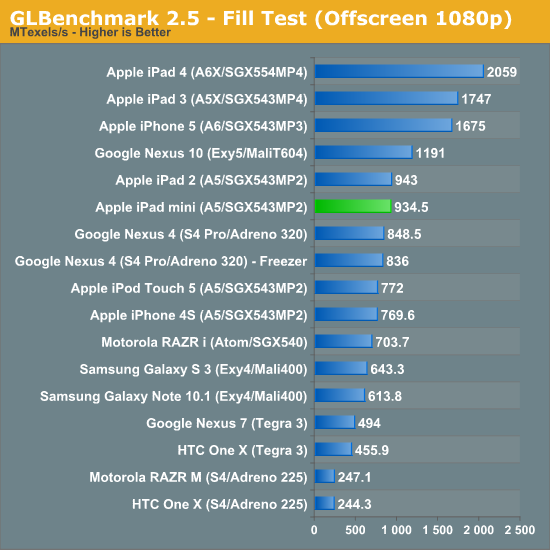
Other than the Nexus 10, the only devices that outperform the iPad mini here are other iPads or the iPhone 5. The mini's low native resolution will help ensure that gaming performance remains high for any currently available content.
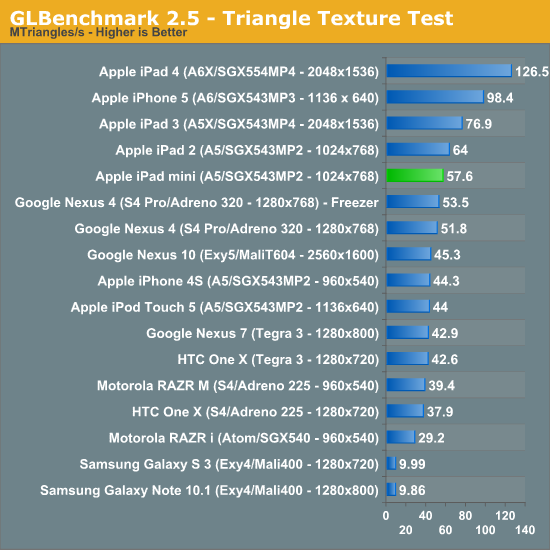

Triangle throughput looks very good here although the Tegra 3 based Nexus 7 is able to pull ahead on the offscreen test.
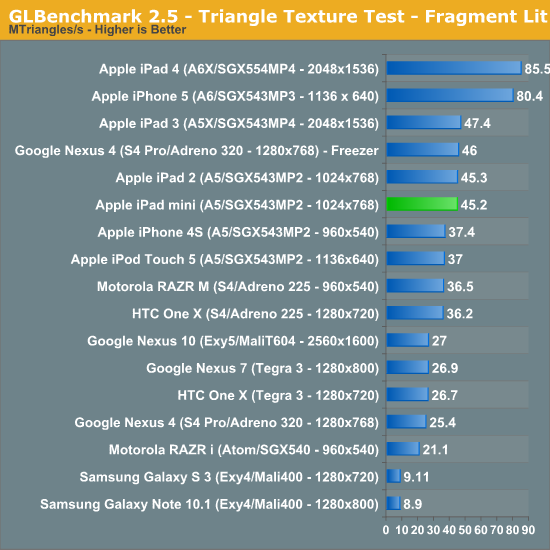
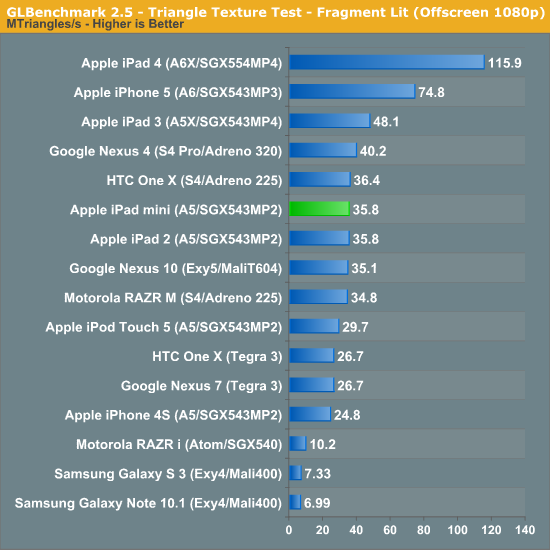
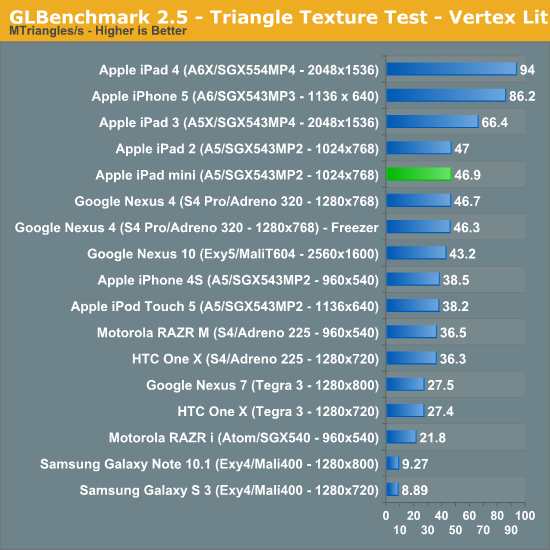
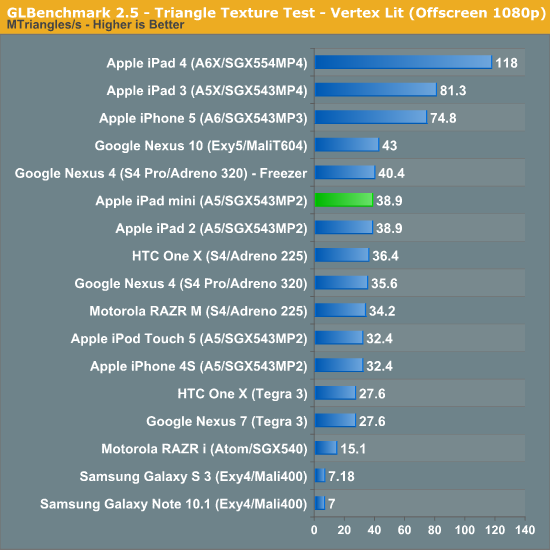
The mini continues to do quite well here vs the competition, although in the heavier triangle tests we see a clear difference between it and the A5X/A6/A6X based iOS devices.
With the synthetics out of the way, we can look at simulated game performance using the Egypt HD and Egypt Classic benchmarks. Remember the on-screen tests are run at native resolution with v-sync enabled, while the offscreen tests are run at 1080p with v-sync disabled for an architectural apples-to-apples comparison.
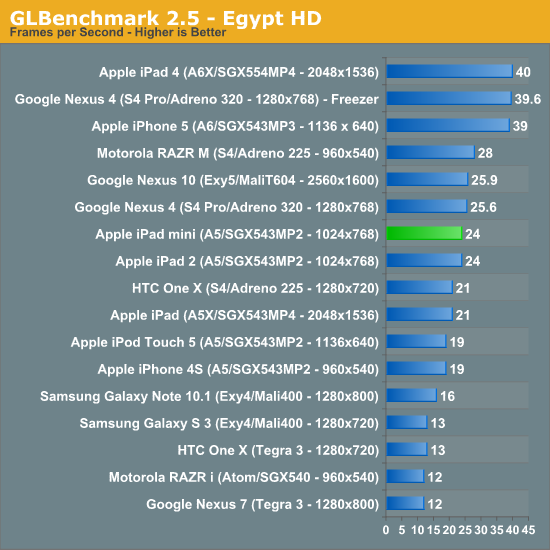
The mini does reasonably well running Egypt HD, which is a good indicator of future gaming performance on the device (perhaps ~2 years out for high end titles). The iPad 4's GPU does a good job of keeping up with its insane display resolution. The Nexus 7 doesn't fare nearly as well. Tegra 3 manages to run most current games just fine, looking forward though the GPU will probably not age too well.
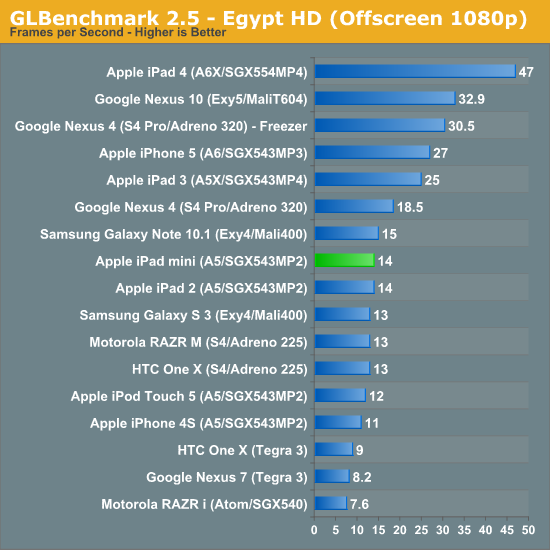
The offscreen tests show us what everything is really capable of given equal footing, and here the mini looks a lot more middle-of-the-road.
The Egypt Classic test is a much lighter workload, as a result most of these devices hit 60 fps at their native resolution:
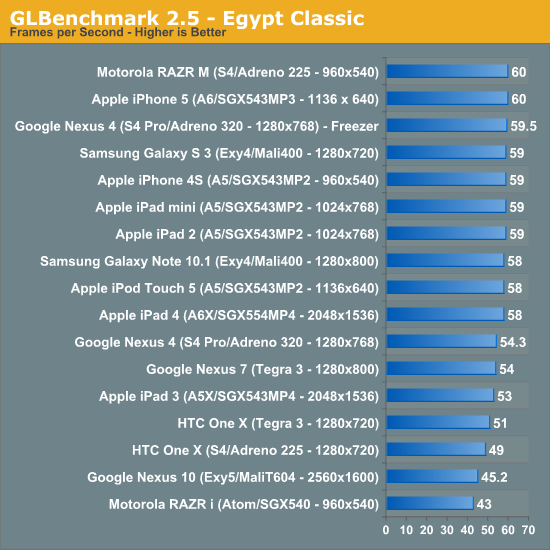
Although Egypt HD is a bit overkill for today's games, Classic undershoots by a good amount. The offscreen test however does provide some guidance as to whether or not these devices would be able to hit 30 fps on an appreciably heavier workload:

The mini does a good job here, although the iPad 3/4 and iPhone 5 are clearly quicker.
Overall the mini isn't a performance slouch. If you thought the iPad 2 was fast enough, the mini won't dissappoint. Its GPU remains very good and should be able to handle both present and upcoming iOS games. That being said, if Apple remains true to its typical cadence and gives next year's mini an A6 SoC I think that will end up being a much better match of price/performance.










140 Comments
View All Comments
Calista - Wednesday, November 21, 2012 - link
^+1I bought the original iPad and as many was amazed by the build-quality (stupid sharp edges excluded) and how fluid surfing the web felt considering the hardware. But I also within 15 minutes realised that it was badly memory-starved. Apple is an amazing company taking great pride in the user-experience of its products, but back then they goofed up badly.
I feel the same about the Mini. The CPU may be old but it's still fairly competent, the GPU still among the best, and the screen size may be close to perfect. But only 512 MB of RAM just ain't sufficient for today, even less for tomorrow.
ltcommanderdata - Wednesday, November 21, 2012 - link
Being slow to increase RAM and VRAM is consistently an issue with Apple. That's the case with Macs as well.For the iPad 1, it wasn't just that 256MB of RAM was small. Rapid drop-off in app support for the iPad 1, especially in games, is due to the resolution being so high in comparison to the RAM. The GPU was also underpowered compared to the resolution. 3rd gen devices have 480x320 screens and 256MB of RAM while the iPad 1 has 5.1x the pixels with the same 256MB of RAM. The 4th gen iPod Touch is affected by this too having a 960x640 screen with 256MB, but the iPad 1 is even worse with 1.3x the pixels of the 4th gen Touch. Support for the 4th gen iPod Touch in games isn't perfect, but is better than the iPad 1, which indicates that 256MB in itself isn't the limitation, but the drop in support for the iPad 1 is a combination of 256MB RAM with the higher 1024x768 resolution and the iPad 1 no longer being sold after 2011. The iPad 1 received 2 major OS updates (iOS 4.x and 5.x) post launch like other iOS devices so its OS support wasn't prematurely terminated.
I think the situation will be different for the iPad Mini 1. The iPad 2/Mini doubles the RAM to 512MB while keeping the resolution the same, which alleviates the poor resolution-RAM ratio of the iPad 1. 512MB of RAM represents the majority of iOS devices including the iPhone 4, iPhone 4S, iPad 2, iPad Mini 1, and 5th gen iPod Touch, of which given historical patterns, the iPhone 4S and 5th gen iPod Touch and perhaps even the iPad Mini 1 itself will sell into 2014. Given historical patterns, OS support for the iPhone 4S, 5th gen iPod Touch, and iPad Mini 1 should continue into 2015. Seeing it's only in 2012 that developers are really beginning to require 512MB of RAM, I don't see them already upping the minimum requirement to 1GB in 2013. Especially not when that eliminates the majority of their potential customer base, when those devices are still being actively sold into 2014, and receiving OS support into 2015. I think 2014 is a more realistic date for when apps will begin to stop supporting 512MB devices.
Personally, seeing the CPU was unchanged and the GPU is only 2x faster despite the 4x increase in resolution making it slower at native resolution than the iPad Mini 1 and iPad 2, I wouldn't be surprised if the iPad 3 loses app support before the iPad Mini and iPad 2.
Of course, just because apps continue to support 512MB devices doesn't mean the usage experience won't be degraded or sub-par. I can see that becoming an issue faster than app support.
Klug4Pres - Wednesday, November 21, 2012 - link
I guess you reviews the Wifi-only version, but I'd like to see some analysis of the cellular connectivity options, especially what LTE bands are supported in the available SKUs.HighTech4US - Wednesday, November 21, 2012 - link
The mini lacks a GPS on the base model making it useless for using any map software with turn-by-turn prompts.The Nexus 7 has a built in GPS chip (and a very effective one and way better pin pointing location than a TomTom) and Google Maps works great on the Nexus 7 (you can download maps for offline use).
The lack of GPS on any tablet is a deal breaker for me.
Adding in the omission GPS with the other short comings along with its sky high price makes the mini just an overpriced iToy. The Nexus 7 is a much much better deal.
Calista - Wednesday, November 21, 2012 - link
I think we have all forgot what gave us forgot what gave us 7" tablets. A "tablet" - i.e a tablet PC running Windows was normally in the 12-14" range. The JooJoo was a 12" tablet as well. Apple brought it down to 10" and sold a ton of those.At the same time a large number of more or less obscure manufacturers brought out 7" tablets *not* because 7" was considered the best compromise but because those panels could be bought dirt-cheap. But this also gave us this idea that a small tablet was supposed to be 7" while a large tablet was to be 10". I would say this is an anomaly, tablets have for the last ten years been larger than 10".
Maybe the "correct" size for a small tablet is in the 8-8.5" range? I was playing with my friends Motorola Xoom 2 (8.2", 1280x800) and while a bit heavier than my 7" tablet it seemed to hit the perfect size. Not so big or heavy as to be cumbersome, while still packing almost 40" more screen area.
Too much focus is being put on the device being pocket-able, how many really bring a tablet in their coat or pants? Just the idea of asking for a device to be pocket-able while still lacking a 3G/4G connection is just plain silly. Instead focus should be put on how it feels in hand but also how much space it occupies on a table. The 10" iPad was always too big to fit comfortable on my table while still having space for a cup of tea, a notebook, a plain book or the remotes for the TV and receiver.
Quad5Ny - Wednesday, November 21, 2012 - link
There is a Pop-over interactive banner ad running that opens when you try to hit the x, please take a look. Thanks.http://forums.anandtech.com/showthread.php?p=34271...
vicbdn - Wednesday, November 21, 2012 - link
"but in terms of repsonsiveness" In the conclusion.BSMonitor - Wednesday, November 21, 2012 - link
Incredibly too much... By the 4th generation of these, 32GB should be standard and 64GB a $100 upgrade...The BOM on 32GB NAND in this fashion is what? $15? Even if it's $20($10 x 2 16GB), they are getting a 1000% profit margin on that upgrade from 16 to 32 GB??
But they know we all have huge iTunes libraries we'd want on it...
Unfortunately there will never be a do-it-yourself tablet similar to the PC market. I stopped paying Dell and Gateway and HP a LONG time ago for their ridiculous profit methods.
TouchPadKing - Wednesday, November 21, 2012 - link
Not sure if this has already been rehashed, but the pixel size is what kills the ipad mini for me. I have a Samsung Galaxy Tab 7.0 Plus, and I can SEE the pixels and it drives me nuts. The ipad mini has an even bigger screen with about the same number of pixels... Also, samsung fits in pocket, mini doesn't. I like the ipad mini's form factor, but again if it won't fit in my pocket it'll probably never leave the house...Rising - Wednesday, November 21, 2012 - link
I bought Nexus 7 when it was released. This is what i can tell you after few months of usage.."Its a good hardware in a crappy software". Iwould say the higher price premium on ipad mini is justified for software.
Most of the apps are zoomed over apps for Nexus 7. I hate that part of it. For example i use this app called apex launcher in my samsung s 3 and when i try using it on Nexus 7 all the icons are so small that they are hardly recognizable.
I donot understand why Google cannot optimize the apps to their own Nexus tablets.
Anand do you know whats stopping them from doing this?